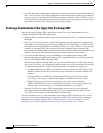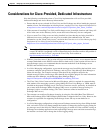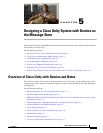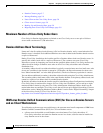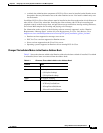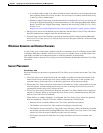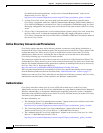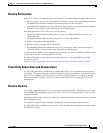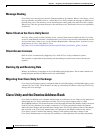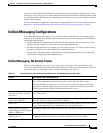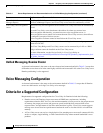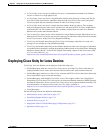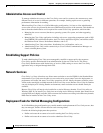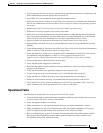
5-6
Design Guide for Cisco Unity Release 5.x
OL-14619-01
Chapter 5 Designing a Cisco Unity System with Domino as the Message Store
Overview of Cisco Unity with Domino and Notes
For additional firewall requirements, see the section “Network Requirements” in the System
Requirements for Cisco
Unity at
http://www.cisco.com/en/US/products/sw/voicesw/ps2237/prod_installation_guides_list.html:
• A single Cisco Unity server can service both local and remote subscribers, especially when
Cisco
Unity is integrated with Cisco Unified Communications Manager (CM) (formerly known as
Cisco Unified CallManager), and when Cisco
Unity is configured for Unified Messaging. In a Voice
Messaging configuration, the message store server must be in the same location as the Cisco
Unity
server.
• If Cisco Unity is integrated with a circuit-switched phone system by using voice cards, ensure that
the Cisco
Unity server is within the maximum allowable cable length of the phone system. If
Cisco
Unity is integrated with Cisco Unified CM or via PIMG or TIMG units, the distance between
the servers is less crucial.
Active Directory Accounts and Permissions
Cisco Unity requires that three Active Directory domain accounts be created during installation, as
described in the Cisco
Unity installation guide. One account is used to install Cisco Unity, another is the
account that most Cisco
Unity services log on as, and the third is used to access the Cisco Unity
Administrator. (Some services, including the Text to Speech service and the service that controls
Cisco
Unity licensing, log on as the local system account.)
The permissions required by each of the accounts are set by the Cisco Unity Permissions Wizard. The
account that Cisco
Unity services log on as can be used by more than one Cisco Unity server in the same
domain. For detailed information on the permissions required, see the Help file Permissions Granted by
the Cisco
Unity 5.0(1)+ Permissions Wizard at
http://ciscounitytools.com/HelpFiles/PW501/PWHelpPermissionsSet_ENU.htm.
These accounts and permissions are required for Cisco Unity–specific functionality and are separate
from the Domino permissions that are described in the
“Domino Permissions” section on page 5-7.
Domino users who are Cisco Unity subscribers do not need Active Directory accounts, and Cisco Unity
administrators and subscribers are not required to use Windows authentication.
Authentication
Cisco Unity subscribers whose class of service (COS) allows them access to the Cisco Unity
Administrator can log on to the Cisco
Unity Administrator by using Domino authentication, Integrated
Windows authentication, or Anonymous authentication, depending on how the system is configured.
Subscribers whose COS allows them access to the Cisco
Unity Assistant must log on to the Cisco Unity
Assistant by using Domino authentication.
For more information, see:
• The “Managing Cisco Unity Administrator Accounts” chapter in the System Administration Guide
for Cisco
Unity Release 5.x (With IBM Lotus Domino) at
http://www.cisco.com/en/US/products/sw/voicesw/ps2237/prod_maintenance_guides_list.html.
• The “Accessing and Using the Cisco Unity Administrator” chapter, also in the System
Administration Guide for Cisco
Unity Release 5.x (With IBM Lotus Domino).
• The “Authentication for Cisco Unity Applications” chapter in the Security Guide for Cisco Unity
Release 5.x (With IBM Lotus Domino), also at
http://www.cisco.com/en/US/products/sw/voicesw/ps2237/prod_maintenance_guides_list.html.



